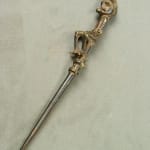Dogon Bronze Pin, 19th Century CE - 20th Century CE
Bronze
0.625 x 6.25
PF.4920
Further images
The continuation of a specific style in art can have a cohesive effect on a people. They become accustomed to associate particular physical attributes with a definite purpose and function....
The continuation of a specific style in art can have a cohesive effect on a people. They become accustomed to associate particular physical attributes with a definite purpose and function. The Dogon are famous for depicting the human form with an ovoid head, squared shoulders and tapered extremities; characteristics seen in this remarkable pin. The figure is in a seated position, hands placed firmly on the knees. His back is very straight and he appears to be bound at the elbows. Protruding from his mouth is a bulbous object that is so large it seems to be puffing out his cheeks. This may be a form of intentional mutilation as part of ritual, or simply to keep the person quiet! Is this figure a prisoner? Was the pin made to be worn by a warrior as a sign of his bravery in battle? Whatever its original purpose, this pin is a handsome example of Dogon art; and as such, presents a style that greatly influenced the art of the West.





